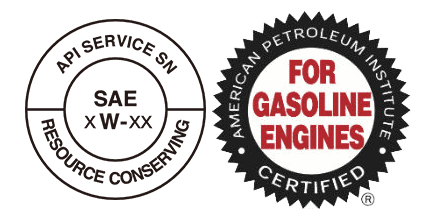
These are the labels you’ll find on every container of reputable motor oil. The API donut on the right tells you if the oil meets the current SL service rating (C for diesel engines). It also provides the SAE (Society of Automotive Engineers) viscosity number and tells you if the oil has passed the Energy Conserving test. The starburst symbol on the left indicates that the oil has passed the tests listed for SL service.
Full API licensing, or certification would impose strict phosphorous limitations on AMSOIL motor oils. This limitation is the main reason most AMSOIL motor oils are not API licensed. AMSOIL INC. currently disagrees with this limitation and feels strongly that the reduced wear and longer oil and additive life achieved through higher levels of properly formulated and balanced phosphorous content is more important than the arbitrary API phosphorous limit that does not give any consideration to the NOACK volatility level of motor oil. When the chemistry is developed that will provide superior engine wear protection with reduced phosphorous levels, or NOACK volatility considerations are put in place, then the phosphorous level will become a non-issue.
Keep in mind that every time a person changes their motor oil, they are introducing a fresh quantity of phosphorus from the new motor oil to the engine’s catalytic converter. By the very nature of providing extended motor oil drains, in a typical application, AMSOIL motor oils actually introduce a smaller volume of phosphorus to the catalytic converter over the life of the engine, which means it is more friendly to the catalytic converter and is actually a more environmentally friendly product to use.